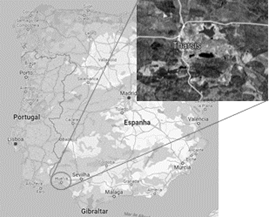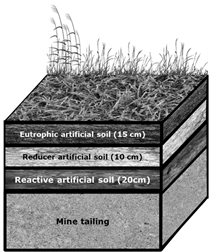Artigo
Acid Mine Drainage remediation through artificial soils with biochar
Remediação da drenagem ácida de minas através do uso de solos artificiais com biochar
Ana Machado1
2
María Otero3
Manuel Sevilla3
Verónica Asensio4
1Ibero Massa Florestal, S.A., Rua Manuel Borges de Oliveira, nº 75, 3720-584, Avenal - UL, Portugal
2 CESAM - Centre for Environmental and Marine Studies, University of Aveiro, Aveiro, 3810-193, Portugal
3 Tharsis Mining S.L., Calle Pueblo Nuevo s/n 21530, Tharsis - Alosno, Huelva, Spain
4 EDAFOTEC SL, Rúa Colón 26 4º Of. 2, 36201, Vigo, Spain
Abstract
Acid mine drainage (AMD) is a serious environmental problem associated with the mine sector when minerals that contains sulfur are exposed. The effluents discharge, in water bodies, with low pH and high metals levels, can pose a threat to the ecosystems, even after the mine exploration ceases. Hence, treatments for the AMD are necessary and can be accomplish by mine restoration actions. The project Mindingsoils aims to mitigate ADM by applying artificial soils with biochar under a circular economy concept, that will promote the reduction of runoff generated, increase of the mine pH runoff and provide metals sorption capacity. To that aim, the mine residues and different biochars (Acacia, Pine and Eucalyptus) were chemically characterized. The results showed that the mine residues, with high level of metals and low pH, will promote environmental negative effects in the adjacent water bodies. From the different tested biochars, Acacia spp. was the feedstock that had more potential for ADM remediation strategies due to its high cation exchange capacity as well as H and O ratios. These results allowed the design of the artificial soil, which will be tested in a pilot field experimental.
Keywords: metals sorption; mine effluents; pollution mitigation; Technosols
Resumo
A drenagem ácida de minas (DAM) é um problema ambiental sério associado à exploração mineira quando minerais contendo enxofre são expostos às condições atmosféricas. Os efluentes gerados com pH baixo e alto teor de metais podem representar uma ameaça para os ecossistemas, mesmo após a mina estar encerrada, e por isso, o seu tratamento é necessário podendo ser atingindo através de ações de restauro. O projeto Mindingsoils tem por objetivo o tratamento de DAM através do uso de solos artificiais com biochar, baseado no conceito de economia circular, que vai promover a redução do escoamento gerado, aumento do pH do escoamento e ao providenciar a capacidade de sorção de metais. Para tal, os resíduos de mina, assim como diferentes biochares (acacia, pinheiro e eucalipto) foram caraterizados quimicamente. Os resultados mostraram que os resíduos da mina, tendo valores elevados de metais e baixo pH, irão promover efeitos ambientais negativos nos corpos de água adjacentes. O biochar de acacia foi selecionado para o presente estudo devido à sua maior capacidade de troca catiónica e a sua proporção de H e O. Os resultados permitiram o desenho do solo artificial, que irá ser testado num ensaio piloto de campo.
Palavras-chave: sorção de metais; efluentes de mina; mitigação de poluição; tecnosolos
INTRODUCTION
Acid mine drainage (AMD) generated from sulfilde mining is one of the most critical environmental pollution issues for the aquatic ecosystems (Akcil and Koldas, 2006). Sulfide minerals, when exposed to oxygen and water, release acidity and metals in the water bodies, compromising the aquatic organism’s survival (Peppas et al., 2000; Nieto et al., 2007). The impact of AMD can last centuries even after the mine exploration ceases. Hence, treatments for the AMD are necessary and can be accomplish by mine restoration actions. Two different strategies can be applied: mine mineral residues remediation (i.e., in situ action), and mine effluents treatment. The latest, is the strategy up to date more commonly used varying from direct effluents chemical treatments to phytoremediation treatments (Ighalo et al., 2022). Nevertheless, due to maintenance deficits, especially after mine exploitation closure, these strategies cannot mitigate efficiently the AMD. In situ action, on the other hand, aims to tackle the source of AMD.
In this scope, the project Mindingsoils aims to mitigate ADM by applying artificial soils with biochar in the mine surface under a circular economy concept. The artificial soil will be created through the valorisation of mine residues and local wastes. This new solution aims to promote the reduction of runoff generated, increase the pH of the mine drainage and provide metals sorption capacity to the soil.
MATERIALS AND METHODOLOGY
The project will implement the new solution, at pilot scale, in the Tharsis mine, located in Huelva, Spain (Figura 1). Tharsis mine residues, produce during the old operation time in the last decades of 20th century, were chemically characterized to acess their potential for the artificial soil integration.
Biochars from Acacia melanoxylon, Pinus pinaster and Eucalyptus globulus wood, produced in a slow pyrolysis process in an oxygen free environment at relatively low temperatures (<700°C), were chemically characterized, for the selection of the biochar feedstock more suitable to the project objective.
Likewise, a selection of residues generated in the province of Huelva were characterized.
RESULTS AND DISCUSSION
The material from the mine waste was strongly acidicic, with high Al3+ concentration, undetectable nitrogen content, and Pb and As concentrations above the generic reference levels for industrial use according to the regional legislation (Table 1). That low pH is probably due to pyrite oxidation, since 53% of the mineral fraction is pyrite.
Table 1 Chemical characteristics of the Mine tailing
| Variable (unit) |
Mine tailing |
| pH |
3.20 |
| Al3+ (cmol(+)kg) |
8.48 |
| Total N (mg kg-1) |
u.l. |
| As (mg kg-1) |
1806 |
| Pb (mg kg-1) |
8489 |
Al3+: exchangeable aluminium, u.l.: undetectable level.
As a consequence of these characteristics of the mine residue, mine water effluents are strongly acidic (pH 1-3), and with a high content levels of Cu, Fe, Zn and sulphates. Another consequence is the absence of spontaneous vegetation in the surface of the mine tailing.
The chemical characteristics analysed in the three tested biochars showed that the made from acacia wood had the highest CEC, proportion of H and O, as well as the highest O/C and H/C ratios (Table 2). Therefore, that was the biochar with the best characteristics for pollutants retention.
Table 2 Chemical characteristics of the biochar made with acacia, pine and eucalyptus wood
| Variable (unit) |
Acac. |
Pine |
Euc. |
| CEC (cmol(+)kg) |
7.09 |
4.61 |
5.77 |
| C (%) |
80.9 |
93.4 |
90.5 |
| H (%) |
3.68 |
1.64 |
2.48 |
| O (%) |
14.9 |
4.76 |
6.89 |
| O/C |
0.19 |
0.05 |
0.08 |
| H/C |
0.05 |
0.02 |
0.03 |
CEC: effective cation exchange capacity, C: carbon, H: hydrogen, O: oxygen, Acac.: biochar from acacia wood, Euc.: biochar from eucalyptus wood.
Based on the objective of increasing the low pH and affection problems in the mine waste and water, it was decided to apply three different layers of artificial soils (Figure 2).
By taking into account the type of residues available in the province of Huelva, as well as their physico-chemical characteristics, the composition of each artificial soil is the following:
1) Eutrophic: pruning residues, DWT sludge, WWT sludge, manure, papermill sludge, CDWs and biochar.
2) Reductor: DWT sludge, WWT sludge, manure and papermill sludge.
3) Reactive: WWT sludge, manure, papermill sludge and biochar.
CONCLUSIONS
The main objective of the Mindingsoils project is expected to be achieved at the end of the field experiment. The artificial soils designed, which includes a specifically selected biochar, have the potential to stop the generation of acid mine drainage and pollutants lixiviation from the mine tailing.
Acknowledgements
The Mindingsoils project has indirectly received funding from the European Union’s Horizon 2020 Research and Innovation programme, via an Open Call issued and executed under project MINE.THE.GAP (grant agreement No873149). Edafotec thanks GAIN for the staff co-financed with the Resolution of the Galician Innovation Agency of December 31, 2019 (“Talento Senior” program).
References
Akcil, A. & Koldas, S. (2006) - Acid Mine Drainage (AMD): causes, treatment and case studies. Journal of Cleaner Production, vol. 14 n. 12-13, p. 1139-1145. https://doi.org/10.1016/j.jclepro.2004.09.006
[ Links ]
Ighalo, J.O.; Kurniawan, S.B.; Iwuozor, K.O.; Aniagor, C.O.; Ajala, O.J.; Oba, S.N.; Iwuchukwu, F.U.; Ahmadi, S. & Igwegbe, C.A. (2022) - A review of treatment technologies for the mitigation of the toxic environmental effects of acid mine drainage (AMD). Process Safety and Environmental Protection, vol. 157, p. 37-58. https://doi.org/10.1016/j.psep.2021.11.008
[ Links ]
Nieto, J.M.; Sarmiento, A.M.; Olías, M.; Canovas, C.R.; Riba, I.; Kalman, J. & Delvalls, T.A. (2007) - Acid mine drainage pollution in the Tinto and Odiel rivers (Iberian Pyrite Belt, SW Spain) and bioavailability of the transported metals to the Huelva Estuary. Environment International, vol. 33, n. 4, p. 445-455. https://doi.org/10.1016/j.envint.2006.11.010
[ Links ]
Peppas, A.; Komnitsas, K. & Halikia, I. (2000) - Use of organic covers for acid mine drainage control. Minerals Engineering, vol. 13, n. 5, p. 563-574. https://doi.org/10.1016/S0892-6875(00)00036-4
[ Links ]
















